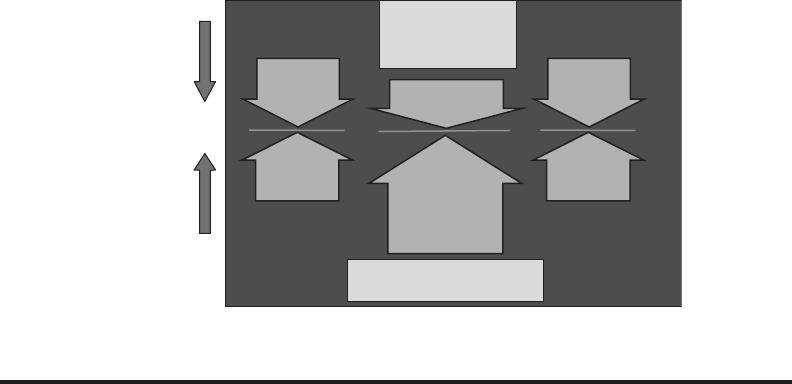
The Entrepreneurial Environment ◾ 77
The Lewin three-stage theory of change model can be more easily visual-
ized as shown in Figure4.18.
4.6.1.2 Force Field Analysis
When rst proposed, the force eld analysis (FFA) became an inuential
development in the eld of social science. Originally applied to social set-
tings, FFA provided a framework for looking at factors (forces) that inu-
ence a situation. FFA looks at forces that either drive toward achieving a
goal (helping forces) or block movement toward a goal (hindering forces).
The FFA principle as developed by Lewin
22
was a signicant contribution
to the elds of organizational development, process management, and
change management.
23
The “eld” was conceived as very dynamic, changing with both time and
experience. When fully constructed, an individual’s “eld” (Lewin used the
term “life space”) describes that person’s motives, values, needs, moods, goals,
anxieties, and ideals.
24
Figure4.19 presents an idealized conception of FFA.
4.7 Leaders Need Followers
“Leaders rarely use their power wisely or effectively over long peri-
ods unless they are supported by followers who have the stature to
help them do so.” —Ira Chaleff
Lewin’s Change Management Model
Unfreezing
Status Quo
(Step 1)
Change
Converting
(Step 2)
Refreezing
New Ways
(Step 3)
Driving forces
Resistance lessen
ed
N
eed for change created
Equilibrium status
Change made permanent
Figure 4.18 Lewin’s change management model—To create change, you rst
“unfreeze” the status quo, and then “refreeze” in the desired new way.

78 ◾ The Guide to Entrepreneurship: How to Create Wealth for Your Company
Followership is a leader’s purposeful guidance and direction in the business
environment. Organizations are successful because not only can their lead-
ers lead, but also how decidedly are followers willing to follow. Followership
is the reciprocal organizational process of leadership.
25
Studying followership is integral to better understanding leadership
because the success and failure of groups, organizations, and teams is depen-
dent on effective leading and following. Specically, followers play a crucial
and active role in organization, group, and team successes and failures.
26
The literature on leadership is deep but, not surprisingly, shallow on
followership. The emergence of the eld of followership in 1988 is widely
credited to Kelly in his inuential Harvard Business Review (HBR) paper “In
Praise of Followers.”
27
Kelly argued that an effective follower is distinguished
from an ineffective one by intelligent, responsible, and enthusiastic partici-
pation in pursuing organizational goals. Kelly further described four main
qualities of effective followers:
28
1. Self-Management: Ability to think critically, to control one’s actions,
and to work independently. Followers must manage themselves effec-
tively so leaders can delegate tasks to these individuals.
2. Commitment: Commitment to the goals, visions, or causes of
a group, team, or organization. This is an important quality of
Resistance
to change
Fo
rces
(incentives)
to change
Equilibrium before
Change
Equilibrium after
Change
Lewin’s Force Field Analysis Model
During
Change
Driving
Forces
Restraining
Forces
Driving
Forces
Restraining
Forces
Driving
Forces
Restraining
Forces
Fear of change
Limited authority
Defense orientation
Culture Inertia
Market forces
Technology improvements
Regulations
Figure 4.19 Lewin’s force eld—Visual depiction of opposing forces that shape goal
achievement.

The Entrepreneurial Environment ◾ 79
followers, as it helps keep one’s (and other members’) morale and
energy levels high.
3. Competence: Possessing skills and aptitudes necessary to complete the
goal or task. Individuals who value this quality often demonstrate more
acute skills than their average co-worker (or team member), continually
upgrading their skills through classes and seminars.
4. Courage: Effective followers hold true to their beliefs and maintain
and uphold ethical standards, even in the face of dishonest or corrupt
superiors (leaders). These individuals are loyal, honest, and, importantly,
candid with their superiors.
4.7.1 Current Views of Followership
Followership has been popularized by Chaleff under the title “The
Courageous Follower.”
29
According to Chaleff, effective followers need
to exhibit three qualities to fully assume responsibilities, as seen in
Figure4.20.
1. Followership intrinsic power. Followers have far more power than
generally acknowledged. Followership entails accepting and under-
standing the sources of its power, working towards the common goal,
and using available tools to achieve the mission.
2. Appreciate leader’s value. Understand the pressures placed upon the
leader, and work to minimize those pressures to contribute to the com-
mon purpose.
e ree Crucial Roles of Eective Followers
Accept and understand followership
intrinsic power
Appreciate leader’s value
Minimize pitfalls of “dark” power
Figure 4.20 The three crucial roles—Leaders must have effective followers.

80 ◾ The Guide to Entrepreneurship: How to Create Wealth for Your Company
3. Minimize pitfalls of “dark” power by helping the leader to stay on
track. If power becomes corrupt, the follower should speak up and pro-
vide constructive feedback to the leader.
Courageous followers share ve characteristics as shown in Figure4.21.
4.7.2 The Followership Universe
It is important to understand that followers and leaders make equivalent
contributions to sustaining organizational viability and advancing the orga-
nization’s goals. Followers within knowledge-based organizations are distin-
guishable at all organizational levels and activities. Figure4.22 presents an
accurate representation of the interactions between followers and their leader.
4.8 Time Management
“The entrepreneurial clock must tick faster than anyone else’s.”
Time is your most implacable enemy. We all have the “same” amount of
time: 24 hours a day, 7 days a week, etc., but entrepreneurs must break the
“tyranny of time.” You must accomplish more each day than the “big guys.”
In 1748, Ben Franklin exclaimed, “Remember that time is money.” To utilize
limited time efciently and effectively, you must practice time management.
The standard denition of time management is planning and control-
ling how time is spent with the goal of effectively accomplishing your
e Five Dimensions of
Courageous Followership
Courage to:
Assume responsibility for
common purpose
Support leader
and group
energetically
Take moral ac
tion
when needed
Participate in
transformation
Constructively
challenge
counterproductive
p
olicies & behaviors
Figure 4.21 The ve dimensions—Followers must be motivated to act courageously.

The Entrepreneurial Environment ◾ 81
goals. Poor time management may be related to procrastination or lack of
self-control.Managing your time involves planning for the future, setting
goals, prioritizing tasks, and monitoring where your time actually goes.
30
Table4.9 summarizes some of the important principles behind practical
time management.
4.8.1 The Urgent-Important Matrix
A time-honored technique used in business management is categoriz-
ing large amounts of data into groups. These groups are often denoted
Quadrants 1, 2, 3, and 4, as they appear in Figure4.23. Each activity is cat-
egorized into a quadrant based on these general criteria:
31
◾ Quadrant 1: Tasks that are perceived as being urgent and important
◾ Quadrant 2: Tasks that are urgent but not important
◾ Quadrant 3: Tasks that are not urgent but important
◾ Quadrant 4: Tasks that are neither urgent nor important
Based on Pareto’s law (i.e., the 80/20 rule), 80% of tasks can be com-
pleted in 20% of the available time while the remaining 20% of tasks will
take up 80% of the time. Following Pareto’s law, it is recommended that
tasks that fall into the rst category (i.e., 80% of them can be completed in
e Followership Universe
Followership
power
Followership
competence
Dominant
Coalition
Organizational Goals
Business Plan
Uncertainty
Markets
Regulations
Competition
Culture
Politics
Extrinsic
Forces
Intrinsic Forces
Leader
Figure 4.22 The followership universe—Leaders and followers make equivalent con-
tributions toward operational viability.
..................Content has been hidden....................
You can't read the all page of ebook, please click here login for view all page.
